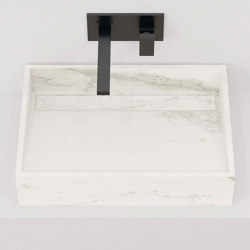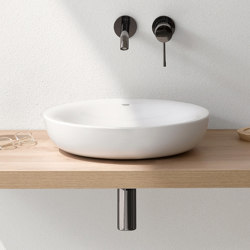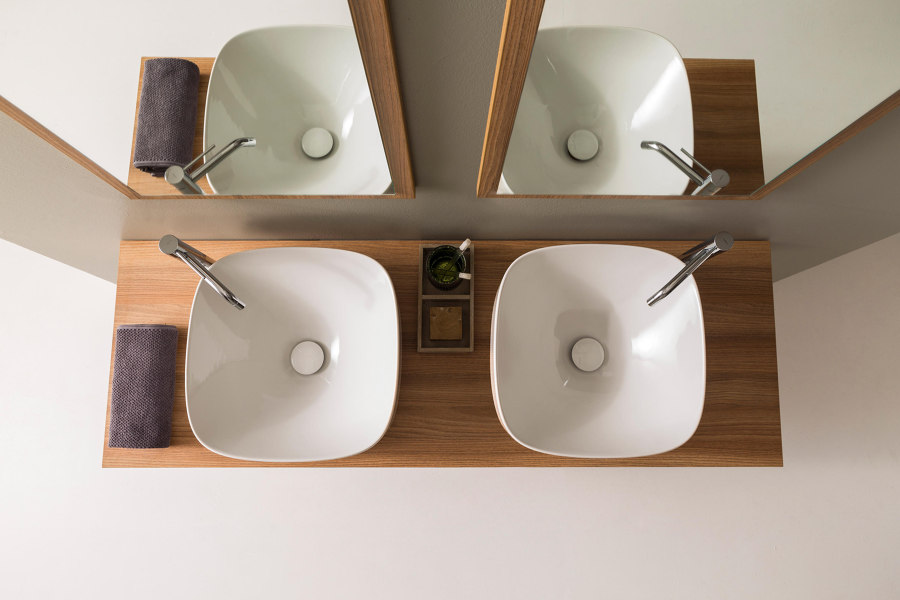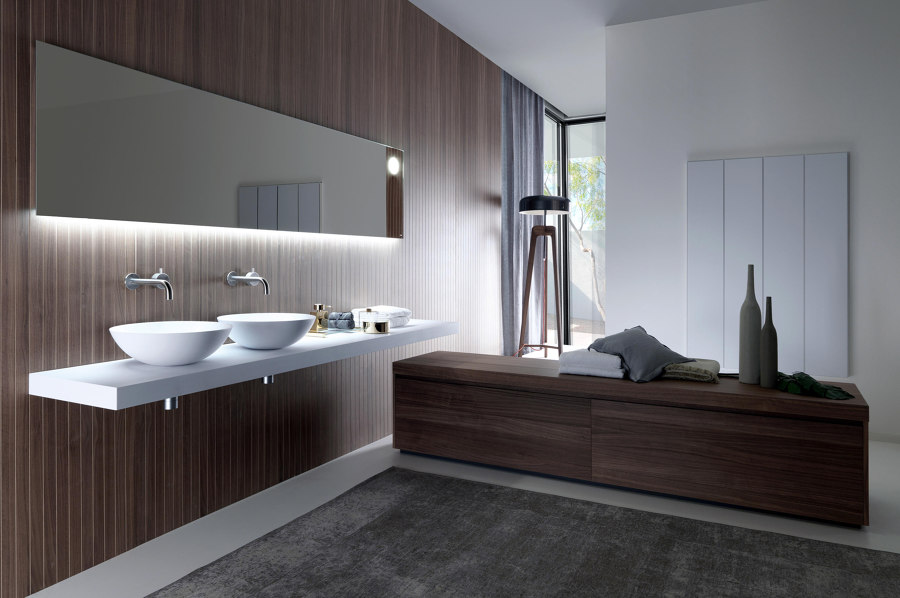Five reasons countertop basins clean up a bathroom’s style
Text by James Wormald
31.07.23
Adding a countertop basin is one of the simplest ways to instantly add a look of modernity to a new bathroom design. But the product category goes far beyond simply style.
Inalco’s square-shaped Hydra countertop basins in mineral composites fit flush to the back of the wall. When combined with wall-fixed tapware, this makes the bathroom far easier to keep clean

Inalco’s square-shaped Hydra countertop basins in mineral composites fit flush to the back of the wall. When combined with wall-fixed tapware, this makes the bathroom far easier to keep clean
×Plumbed-in bathroom washbasins have for a long time been inseparable from the load-bearing frames on which they sit, formed either from similarly styled ceramic pedestals that become one shapely form, or before that, tubular steel or ironwork. Think back further still, to a time before plumbed-in water supplies, and the washbasin was nothing more than a ceramic bowl on the flat surface of a washstand, with space alongside for a jug.
By renewing the trend of countertop washbasins, designers can increase functionality and creativity
By renewing this trend of separating the basin away from the countertop, but keeping the plumbing, designers are able to provide more usable surface space in the bathroom – increasing both the functionality of the washstand itself, and the creative opportunities it provides. Here are some of the advantages of countertop basins, and a selection of examples, from the Architonic database.
Countertop basins like Grohe’s Essence Vessel (top) provide more flat storage space, while Ideagroup’s Dressy (middle) and Dogma10 (bottom) vanity units show off more storage or open space below

Countertop basins like Grohe’s Essence Vessel (top) provide more flat storage space, while Ideagroup’s Dressy (middle) and Dogma10 (bottom) vanity units show off more storage or open space below
×Give yourself more space
The two main features of a washbasin include the original design intention – a bowl used to wash oneself’s hands and face – and a surrounding surface on which to place accessory objects such as soap and other sanitary or beauty products. By separating the two surfaces, countertop basins like Essence Vessel from Grohe allow these items to be held securely, while the additional surface space also allows temporary objects from one’s hands – like a phone – to be secured, safe from slippage.
Another advantage of the countertop basin, meanwhile, is that they allow the space otherwise taken by the concave basin to occur above the counter, opening up the area below for use as storage – as seen in the deep drawers of the Dressy vanity unit by Ideagroup, or even the opened-up space below the Dogma 10 cabinet which reduces its visual weight, also from Ideagroup.
Contrasting colours, finishes and materials are made simple, seen here with Scarabeo Ceramiche’s Moon basin (top), VitrA Bathrooms’ Water Jewels collection (middle) and Glass Design’s Extreme basin (bottom)

Contrasting colours, finishes and materials are made simple, seen here with Scarabeo Ceramiche’s Moon basin (top), VitrA Bathrooms’ Water Jewels collection (middle) and Glass Design’s Extreme basin (bottom)
×Make a clean impression with contrasting colour and material
Another advantage of splitting the washbasin and the countertop, is the ability to contrast them in opposing colours, materials or even styles. As flat, stable, waterproof surfaces, the material considerations for bathroom counters are as varied as those for kitchen worktops, including the natural grain of wood contrasting against clean white ceramic, such as the Moon washbasin from Scarabeo Ceramiche, or opposingly more colourful basin options like the full metallic finishes, metallic-rimmed finishes, or bright colour contrasting options of VitrA Bathrooms’ Water Jewels collection, when teamed up with simpler neutral counters.
Split countertops and basins can be contrasted in opposing colours, materials or styles
If a countertop or the accompanying surface of a backsplash provide an especially pretty finish, however, why allow the opaque form of a countertop basin to block it out? Glass-edged basins like the Xtreme range from Glass Design provide a sleek tank that holds water in place when needed, but keeps background colours and patterns in view throughout.
Circular basins like falper’s Viaveneto (top) and LAGO’s tilted Inbilico basin contrast with surrounding linear styles, while Bette’s Balance Shell basin (bottom) contrasts with its own vertical edge (bottom)

Circular basins like falper’s Viaveneto (top) and LAGO’s tilted Inbilico basin contrast with surrounding linear styles, while Bette’s Balance Shell basin (bottom) contrasts with its own vertical edge (bottom)
×Work out the angles with a shapely countertop washbasin
Although the shape of a washbasin is generally dictated by the specified style of the bathroom as a whole, there’s more to consider about the shape of a countertop basin. While separated countertop basins allow designers to complement one material with a contrasting one, the same can be said for the shape of the basin, too. By placing a circular-shaped basin above a rectangular counter, for example, as falper has done in the showroom bathroom for its Viaveneto basins, a pleasing geometrical connection is made between the two, and the Inbilico basin from LAGO also manages to soften the look of the accompanying countertop’s hard-edged marble surface.
The straight-edged basin’s 90-degree connection to the countertop makes it simple to clean
Moving focus over the edge of the bowl, meanwhile, basins like Bette’s Balance Shell contrast curved with straight edges by keeping their vertical axis straight. The clean lines speak freely with the rest of the bathroom’s design language, whichever form they take, while the straight-edged basin’s 90-degree connection to the countertop also makes it simple to clean.
In the shape of cupped hands, Glass Design’s Kool basin (top) invites users in and protects surroundings from splashes, and Inalco’s flush-fitting square Hydra basin (middle, bottom) catches wall-fixed drips

In the shape of cupped hands, Glass Design’s Kool basin (top) invites users in and protects surroundings from splashes, and Inalco’s flush-fitting square Hydra basin (middle, bottom) catches wall-fixed drips
×Make a splash without making a splash
The ease with which a bathroom is cleaned is, perhaps, one of the last considerations made by end users – well after more enjoyable discussions on style and usability. It can, however, be of equal importance, because as rejuvenating as water is, it can cause real problems when it goes where it shouldn’t.
Square basins pushed up to a surface edge can catch the splash of wall-fixed taps
With a specialist form, countertop basins are able to curve around the problem. Glass Design’s Kool washbasin, for example, opens low at the front to invite hands into the wash space, and yet protects neighbouring surfaces from stray splashes with its steep rear edge. Alternatively, by selecting a wide, square-shaped basin and pushing it right up to the surface edge, well underneath both the serving tap’s spout and mixer, as does the Hydra basin from Inalco, users are able to wash, then turn the tap off, without splashes leaving the basin area.
Countertop basins can set the faucet free. Circular basins like ConSpire’s Udinesse (top) have a natural open corner, while Fantini’s ceiling-fixed tap (middle, bottom) proves there’s no limit to creativity

Countertop basins can set the faucet free. Circular basins like ConSpire’s Udinesse (top) have a natural open corner, while Fantini’s ceiling-fixed tap (middle, bottom) proves there’s no limit to creativity
×Keep everything in line with freedom for the faucet
Often without their own holes for taps, countertop basins afford designers creative freedom over exactly where, and how, to serve them with water. Wall-fixed taps, for example, can be positioned anywhere on a vertical line above the basin, a pleasing equidistance between basin and mirror, for example. Meanwhile, tall countertop-fixed taps are a perfect solution, when combined with circular basins like the Udinesse Concrete basin from ConSpire, to fit neatly into the small corner created along the edge of the basin. Alternatively, Fantini has taken the creative freedom of tap positioning to, arguably, its most extreme with the Fontane Bianche Salvatore + Fantini mixer, which can protrude down all the way from the ceiling, up to 135cm.
© Architonic
Head to the Architonic Magazine for more insights on the latest products, trends and practices in architecture and design.




































